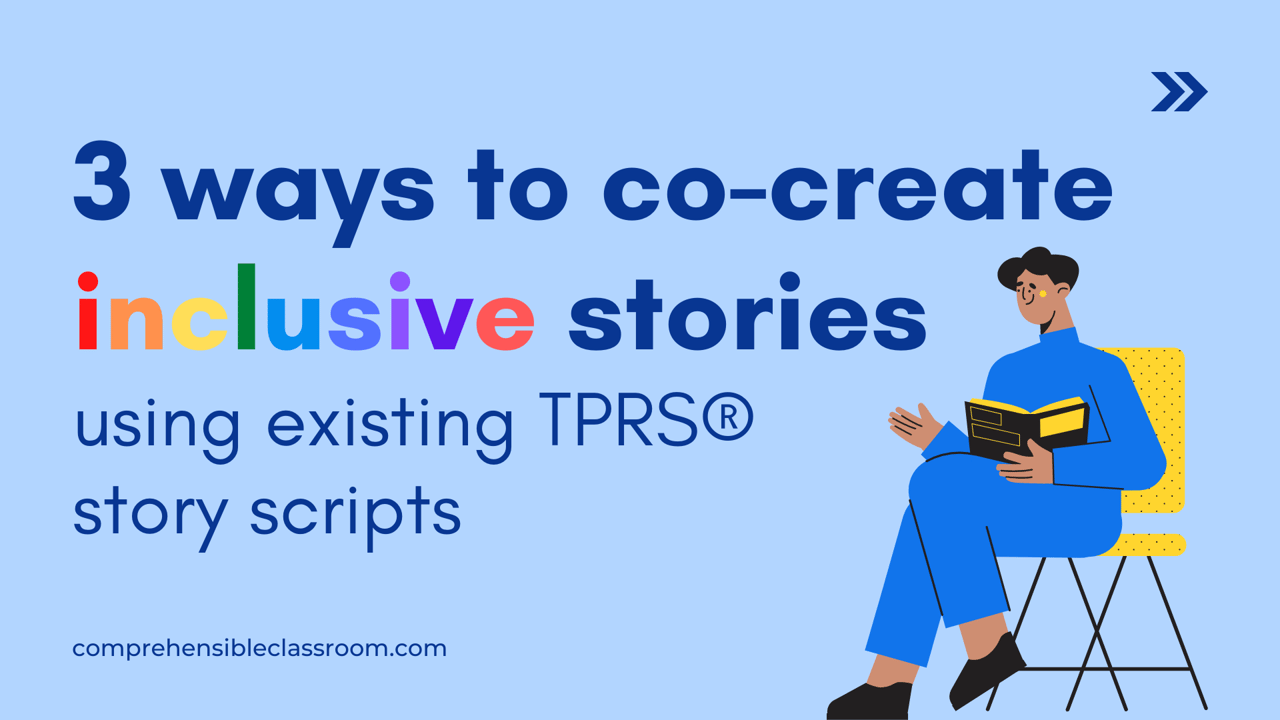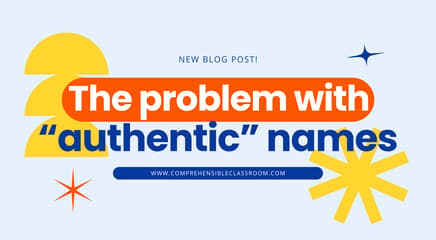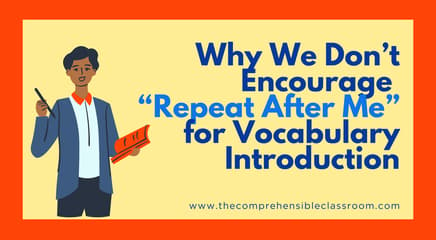Teaching Proficiency through Reading and Storytelling (TPRS®) is a method for teaching language in which the teacher and students co-create stories. While some teachers prefer to create stories from scratch, many others have found it helpful to have a starting point–a script– and there are many scripts available to language teachers. Every script is an outline, and students in class work together to build a story using the infrastructure of the script.
One question that we hear often is, "I want to improve representation of LGBQT+ characters in my stories; but how can I do this if they're not in the script?". If you have ever found yourself wondering how you can co-create more inclusive stories with your students, keep reading! We've going to look at three areas in which you can create space for LGBQT+ characters, families, and celebrities in any story.

3 ways to co-create inclusive stories using existing TPRS® story scripts
by Elicia Cárdenas and Martina Bex
Here are three starting points for creating more inclusive stories based on existing scripts. To some, these suggestions may seem simple and obvious– yet even simple things can go a long way in helping all of your students to feel seen, welcome, and represented in your stories.
If this content resonates with you, we recommend connecting with Anna Gilcher and Rachelle Adams of ELEVATE CI, an organization whose mission is to Elevate humanity through language education, and whose work has helped us to look critically at the stories we create and the scripts that we write, and who ultimately inspired the ideas shared in this post.
Invite LGBQT+ characters into your stories
Instead of assigning a gender to all of your characters, create space for nonbinary characters. For example, describe characters as “is a person” instead of “is a boy/man” or “is a girl/woman”. As the class is co-creating a character, you can also ask them to decide which pronouns their character uses.
If the idea of using inclusive language is new to you or you are unsure about it, we invite you to adopt one of our Collaboration Group norms, which is to "Be willing to try on new ideas". Earlier this month, Abelardo Almazán-Vázquez shared what he describes as his testimony with the Collab group, and we encourage you to make time to watch, listen, and consider his message. As you will see in this presentation, using inclusive language will look differently for each one of us, and there is a 'next step' (or a 'first step') for all of us.
Curious about inclusive language? Watch this recorded Facebook Live with Abelardo Almazán-Vázquez, and connect with Abelardo on Twitter to keep learning.
In addition to creating space for nonbinary characters/gender identities in your stories, you can also invite LGBQT+ characters in through the portrayal of any romantic relationships that might be mentioned in the story. If the script says that your character has or wants to have a boyfriend or girlfriend and the pre-filled example in the script portrays a heterosexual relationship, remember that your students don't have to place the character in a heterosexual relationship. When fishing for details to keep the story moving forward along the script, ASK, DON’T ASSUME the gender of a scripted partner. If your character is male, ASK if they have a boyfriend or a girlfriend (or the neutral term ‘partner’) instead of just stating that they have a girlfriend and then asking the class to decide on a name.
Invite LGBQT+ families into your stories
If the script says that your character talks to a parent -or- if your class suggests that your character talk to a parent at some point during the story, ASK, DON’T ASSUME the genders of the character’s parents. For example, if the class suggests that the character talk to his dad, you can ASK questions like, “Does he have 1 dad or 2 dads?”, or “Does he talk to his dad or does he talk to ONE of his dads?”.
Invite LGBQT+ celebrities into your stories
It can be great fun to introduce well-known, real-world figures as characters in your class’ stories! As you suggest possible famous characters to your students, include LGBQT+ individuals. In particular, introducing nonbinary public figures creates opportunities for students to experience the authentic use of inclusive language, such as gender neutral pronouns.
An invitation that says, "You are welcome here".
Co-creating inclusive stories isn't about forcing LGBQT+ characters into your stories. Storyasking is a beautiful, connecting process that ideally results in a story over which everyone in the class feels ownership. The four examples outlined in this post are ways that you can CREATE SPACE in your stories for LGBQT+ characters to enter– but remember, your class gets to decide the details! The goal here is to show them through the questions you ask that your stories are safe spaces, and that every character is welcome within them, just as every student is safe and welcome in your classroom.
Furthermore, we encourage you to view the three suggestions shared in this posts as STARTING points. Each question that you ask students in the process of deciding a story detail can be just a question - a question that is answered by the students, and then you move on to the next part of the story. Something as simple as an either/or question can lead to a more inclusive storyasking experience by creating space for characters with identities and sexualities that aren’t written into the script to enter your story.
If you and your students are ready and able to dig deeper, a simple question intended to decide a story detail can then serve to open up a bigger conversation. The amount of time that you spend talking about each of these story details will vary based on how relevant it is to the story, your own comfort level, your teaching context, and your students’ level of proficiency, as well as their interest in that particular detail.
Learn and grow
We recommend connecting with Anna Gilcher and Rachelle Adams of ELEVATE CI, an organization whose mission is to Elevate humanity through language education, and whose work inspired the ideas shared in this post. One of their specific areas of work is to support teachers in co-creating TPRS® stories that elevate humanity.
ACKNOWLEDGEMENT
TPRS® was developed by Blaine Ray. In 2008, Mr. Ray's company made a donation that directly harmed members of the LGBTQ+ community. We advocate for the use of TPRS® as an excellent methodology for language teaching even as we stand in opposition to harmful actions taken by its creator.




